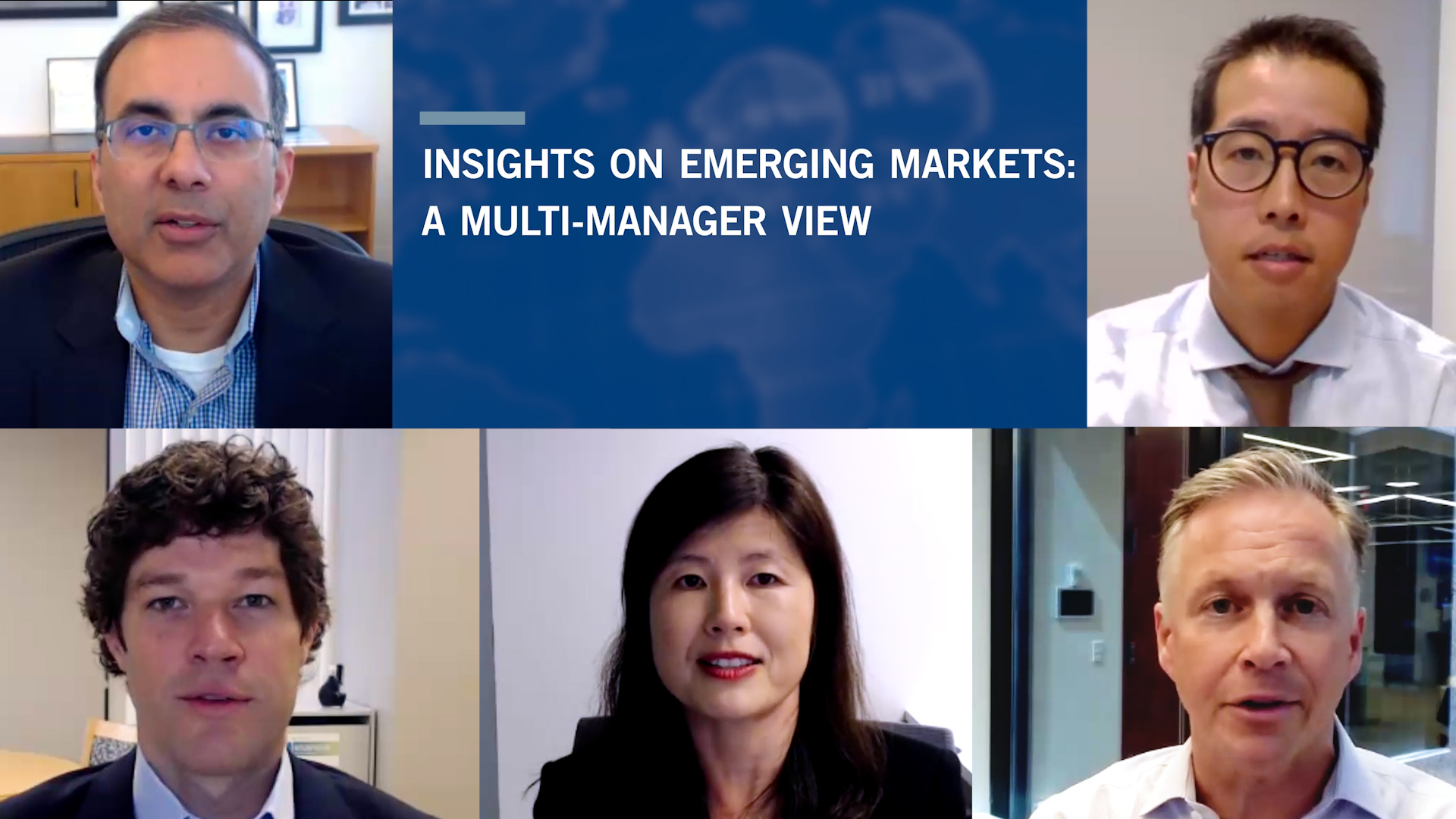Portfolio managers from Virtus affiliates Kayne Anderson Rudnick, NFJ Investment Group, Stone Harbor Investment Partners, Sustainable Growth Advisers, and Virtus Systematic share their views on emerging markets, including the impact of the Federal Reserve, current valuations, and why investors might be interested now.
Transcript
Kishore Rao
Portfolio Manager and Analyst
Sustainable Growth Advisers
After many years of U.S. outperformance, why should an investor consider rebalancing toward EM today?
There is a massive boom in [Emerging Markets] EM middle class spending. Brookings estimates that the global middle class consumer spent $30 trillion in 2015, but that figure is poised to double by 2030 to $60 trillion. The growth is especially pronounced in Asian countries and within that set of Asian countries, there are some that have tremendous demographics and strong democratic governance structures, such as India. But despite this incredible wealth creation opportunity, EM and international stocks have dramatically underperformed U.S. stocks for more than a decade. But history shows, these kinds of performance cycles tend to mean revert and we see a couple potential catalysts that could trigger a recovery in the performance of emerging market stocks. One could be the possibility of U.S. [Federal Reserve] Fed rate cuts towards the end of this year or into 2025, and also the resolution of any electoral uncertainty in key large democracies like India, Brazil, and Mexico in the coming months. And so for all these reasons, we're quite optimistic about emerging markets in the decade ahead.
John Mowrey, CFA
Chief Investment Officer, Senior Portfolio Manager/Analyst
NFJ Investment Group
Where do you see opportunity in EM value companies now?
We think emerging markets are particularly attractive for investors for three reasons. The first is valuation. Valuations, measured by price to book, are the steepest discount to develop markets going back to 2001. In addition, dividend yield is actually at the highest premium going back to the same level. Secondly, growth rates are particularly attractive in the emerging markets, as they are actually growing faster than the developed markets at around 17% on a forward basis versus 9% for the world index. And thirdly, if you look at currencies, the dollar is at the strongest level going back to 2001 and that's a consequence of what the Fed is doing with high interest rates. When that begins to weaken, we think that could spark a large rally in the emerging markets. So for these three reasons, we think it would be wise for investors to consider allocating to emerging markets.
Where do you see opportunity that “reshoring” represents for investors in EM?
Supply chains post-COVID have continued to mature and emerge at the same time. For example, we are seeing India and Indonesia particularly become attractive partners to the U.S. in terms of supply chains. That being said, we think investors should still not take their eye off China, as it is the second largest economy in the world and is deeply embedded in the supply chains, from manufacturing to electronics. In addition, reshoring is continuing to take hold. For example, Taiwan Semi[conductor] was just granted $6 billion from the US government to increase development of chips in the U.S. As a consequence, we think all these things are important and are a function of maturing global supply chains.
Lu Yu, CFA, CIPM
Managing Director, Lead Portfolio Manager
Virtus Systematic
How do you anticipate the Federal Reserve’s expected rate cuts later this year will impact EM stocks?
In the recent [Federal Open Market Committee] FOMC press conference, Fed Chairman [Jerome] Powell mentioned this phrase ‘over time’ quite a few times. He was talking about how we will reach the 2% inflation target over time. And this implies that the Fed might give up the 2% inflation target or there is an extended timeline to reach that. And usually when the Fed starts cutting interest rates, it is good news for emerging markets. And this is our outlook, that the Fed is going to start cutting rates in the second half of the year and that should bode well for emerging markets.
Are EM stocks considered “cheap” relative to U.S. stocks and their opportunity set?
The valuation between the global markets and U.S. market has widened since 2010. If we look at the [Cyclically Adjusted Price/Earnings] CAPE ratio, which is the earnings per share over the 10-year time horizon, you will find that starting from 2010, the global markets evaluation stays about 15x, while, for U.S. equity markets, it has been rerated from 15x all the way to 35x. And we believe the gap between these two markets has been so wide that investors will start looking into investing their money in foreign markets. We believe the rerating of the U.S. market will stop and investors will deploy more assets and capital into foreign markets, including emerging markets.
Hyung Kim
Portfolio Manager and Senior Research Analyst
Kayne Anderson Rudnick
Why should investors consider EM small caps?
The main attraction to emerging markets, from an investment standpoint, is faster economic growth, along which comes other interesting developments such as the rising middle class or technological innovation. And small cap gives investors a direct exposure to these interesting developments in these local economies, whereas large cap tends to have exposure to companies that are much more global in nature. For example, TSMC [Taiwan Semiconductor] and Samsung Electronics generate a big chunk of their profits outside of emerging markets. Small cap also tends to be a much more inefficient space with less broker coverage and less investor following, and this enables us to find very interesting and compelling investment opportunities.
Lastly, I'll point out that EM small cap has had very strong performance recently. The MSCI EM small-cap index was up over 24% last year versus only 10% for the large cap index, and this may be a surprise to some people, but many emerging market countries massively outperformed even the S&P 500 last year. So, for example, Poland's small cap was up over 60% last year and India, Taiwan and Mexico were up over 40%, and Brazil and South Korea were up around 30% last year. So, it's not true that emerging markets always underperform the U.S. and last year would have been an example of a period in which having some diversification exposure to EM small-cap would have paid off handsomely.
Jim Craige, CFA
Chief Investment Officer, Head of Emerging Markets
Stone Harbor Investment Partners
Why have both investment grade and non-investment grade EMD, with rare exception, outperformed competing fixed income asset classes? Will it continue?
We believe emerging markets debt will outperform competing fixed income classes. The first reason is because the growth is higher. We are where the growth is at. Emerging countries have better demographics, with a younger population, which is driving the emerging middle class, and that has led to emerging markets now receiving two-thirds of all global investments. And that's led emerging markets to consistently show growth rates of 1 to 3% higher than the developed market. We expect this to continue. Secondly, yield. For similar credit quality, emerging bonds yield more than developed market bonds. And most of the return in fixed income comes from yield. The extra spread you are receiving is much greater than that required to compensate you for any default risks. It's significant outright and relative to competing assets. For example, single B credits in the United States yield around 7.4%. Emerging markets single B sovereign credits yield around 8.7%. While single B Corporates yield roughly 9.3%. That's like getting a 2 to 3 notch upgrade for free. And that adds up. In the high yield space over the past 20 years, a mix of emerging markets, Corporates and sovereigns have outperformed the US and global high yield corporate market by 40 to 50 basis points annually. Take the yield and let it do the work for you.
How has EM credit quality changed over the past several years? Where is it now, relative to other fixed income markets?
Over half of the emerging markets debt market is investment grade. But after COVID, the Fed fears, the Russia Ukraine war, downgrades were in excessive upgrades. There was a real fear of economic uncertainty that drove most of that. Ratings agencies had a hard time handicapping the likelihood of a significant growth downgrade. Well, that growth decline didn't happen. We still grew, and grew in excess of the developed markets. So now we're on the other end of the cycle, upgrades are in excess of downgrades. And certainly the growth advantage had a big part of that, but what also helps is that emerging countries are running current account surpluses and have a debt-to-GDP [gross domestic product] ratio, which is about half that of the developed markets. So use the growth advantage, use the improving credit quality that we're seeing in the market and most important, use the yield advantage to your benefit.
Virtus Investment Partners provides this communication as a matter of general information. The opinions stated herein are those of the author and not necessarily the opinions of Virtus, its affiliates, or its subadvisers. Portfolio managers at Virtus make investment decisions in accordance with specific client guidelines and restrictions. As a result, client accounts may differ in strategy and composition from the information presented herein. Any facts and statistics quoted are from sources believed to be reliable, but they may be incomplete or condensed and we do not guarantee their accuracy. This communication is not an offer or solicitation to purchase or sell any security, and it is not a research report. Individuals should consult with a qualified financial professional before making any investment decisions.
All investments carry a certain degree of risk, including possible loss of principal.
Past performance is not indicative of future results.
3516434





